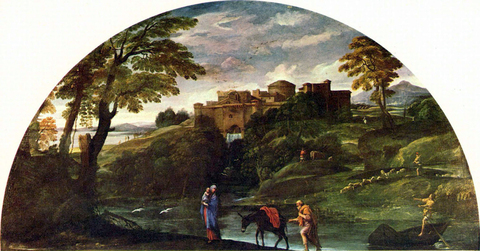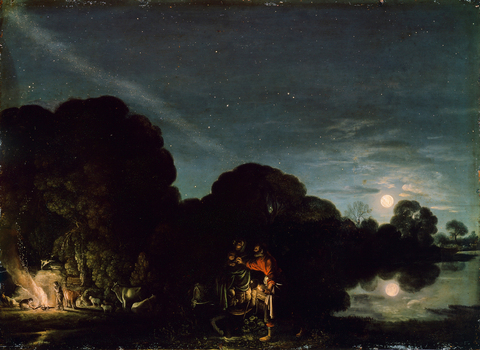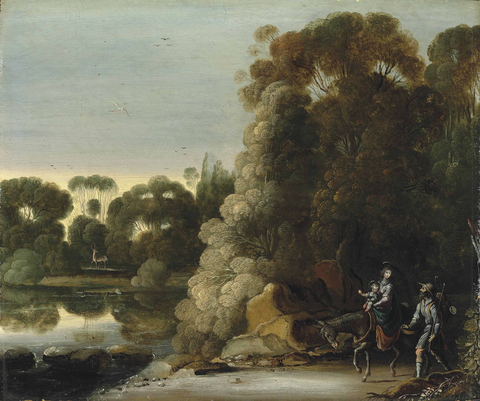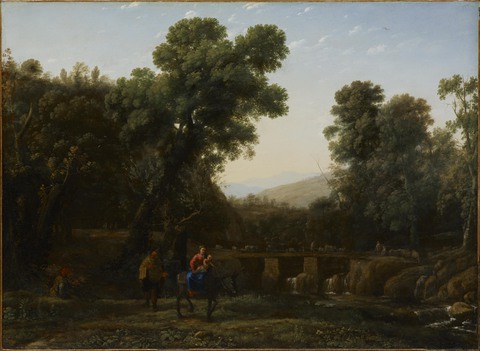Marks, Inscriptions, and Distinguishing Features
Signed, bottom center, heavily abraded: CLAV[ ] I(N)V(ENIT)
Entry



Author
Provenance
Vincent Donjeux (died 1793), Paris, by 1773;15
Henry John Temple, 2nd Viscount Palmerston (1739–1802), Broadlands, Hampshire, England, in 1773;16
By descent within his family to Evelyn Ashley (1836–1907) until 1889;
(Thomas Agnew and Sons, London);
Sir Edward Cecil Guinness (1847–1927), later Earl of Iveagh, Dublin and London, in 1889;17
By descent within the family to executors of the estate of Arthur Ernest Guinness (1876–1949), Holmbury House, Surrey, until 1953;
Intended sale at (Christie’s, London), in 1953, but sold prior to auction;18
(Knoedler Galleries, New York, with Thos. Agnew & Sons, London, and Pinakos Inc., New York), in 1953;19
(Thos. Agnew & Sons, London);
Mrs. G.H.A. (Edith Whitehill) Clowes, Indianapolis, in 1959;
The Clowes Fund, Indianapolis, from 1959–2003, and on long-term loan to the Indianapolis Museum of Art since 1971 (C10052);
Given to the Indianapolis Museum of Art, now the Indianapolis Museum of Art at Newfields, in 2003.
Exhibitions
British Institution for Promoting the Fine Arts in the United Kingdom, London, 1828, Pictures by Italian, Spanish, Flemish, and Dutch Masters, no. 32, as Morning;
Royal Academy, London, 1884, Exhibition of Works by The Old Masters, no. 162;
Thos. Agnew and Sons, London, 1957, Recently Acquired Pictures by Old Masters, no. 11;
John Herron Art Museum, Indianapolis, 1960, Indiana Collects, no. 36 (reproduced);
Wildenstein, New York, 1978, Romance and Reality: Aspects of Landscape Painting, no. 14 (reproduced);
Guangdong Museum, Guangzhou; Hunan Museum, Changsha; Chengdu Museum; 2020, Rembrandt to Monet: 500 Years of European Painting.
References
John Preston Neale, Views of the Seats of Noblemen and Gentlemen in England, Wales, Scotland, and Ireland (London: Sherwood, Neely, and Jones, 1819), 2:59, as “a landscape, with figures of the Holy Family”;
Important Pictures by Old Masters and Pictures and Drawings, sale cat., Christie’s, London, 10 July 1953, no. 57;
Recently Acquired Pictures by Old Masters, exh. cat. (London: Thos. Agnew and Sons, 1957), no. 11;
Art News (Summer 1957): 65;
Illustrated London News (14 December 1957): 36 (reproduced);
Marcel Röthlisberger, “Les fresques de Claude Lorrain,” Paragone (January 1959): 48, 50n26;
Marcel Röthlisberger, Claude Lorrain: The Paintings, 2 vols. (New Haven: Yale University Press, 1961), 1:466; 2:fig. 35 (reproduced);
Mark Roskill, “Clowes Collection Catalogue” (unpublished typed manuscript, IMA Clowes Archive, Indianapolis Museum of Art, Indianapolis, IN, 1968);
Marcel Röthlisberger and Doretta Cecchi, L’opera completa di Claude Lorrain (Milan: Rizzoli Editore, 1975), 91 (reproduced);
Denys Sutton, Romance and Reality: Aspects of Landscape Painting, exh. cat. (New York: Wildenstein, 1978), no. 14, fig. 13;
Ellen Wardwell Lee, ed., Indianapolis Museum of Art Highlights of the Collection (Indianapolis: Indianapolis Museum of Art, 2005), 106 (reproduced);
Kjell M. Wangensteen et al., Floating Lights and Shadows: 500 Years of European Painting (Jiangsu Phoenix Literature and Art Publishing: Nanjing, 2020), 156–159 (reproduced).
Technical Notes and Condition
The painting has been relined in the twentieth century and retouched. The stretcher is in stable condition, and the few areas of visible original canvas are also in good condition; visible cusping along all four edges proves that the work is still roughly its original size. Slight degradation of the image has occurred over the centuries. There has been some abrasion to the upper paint layers and glazing due to restoration campaigns before the twentieth century, while the relining of the canvas resulted in the flattening of any areas of impasto. Some blanching (or obstructing opacity) of the surface layer of the painting may also have occurred, due to improper removal of varnish with solvents during previous restorations. It was treated most recently in 1978–1983 to remove yellowed varnish and replace old overpaint with retouching in AYAB and dry pigments.
The ground, formed by a chalky, off-white layer of medium thickness, exhibits moderate, typical cracking, but it is intact. Some underpainting in a black carbon-based pigment was carried out in the initial phase, to which a lead white primer was applied. Much of the blue color in the sky area was painted with ultramarine blue, and the evidence of the use of other blue pigments probably can be attributed to restorers' inpainting interventions in modern times. The paint, likely mixed with linseed oil, was applied with both wet-in-wet and wet-over-dry techniques, to achieve diverse illusionistic effects.
Although there are remaining signs of woodworms in the modern reproduction frame, there is no current infestation and the frame is structurally sound.
Notes
-
The scholarship on the artist’s contested birth date is summarized in Marcel Röthlisberger, Claude Lorrain: The Paintings, 2 vols. (New Haven: Yale University Press, 1961), 1:4; Röthlisberger found the arguments for the 1600 birthdate to be definitive. ↩︎
-
This claim of forgers counterfeiting Claude’s works was recorded in the seventeenth-century biography of the artists written by Filippo Baldinucci (1624–1696). This entire biography by Baldinucci is published in English translation in Marcel Röthlisberger, Claude Lorrain: The Paintings, 2 vols. (New Haven: Yale University Press, 1961), 1:53–62; the relevant passage is at 1:59. ↩︎
-
Cited in Richard Rand, Claude Lorrain: The Painter as Draftsman; Drawings from the British Museum (New Haven: Yale University Press, 2007), 25. ↩︎
-
This theory is explained and rejected in Marcel Röthlisberger, Claude Lorrain: The Paintings, 2 vols. (New Haven: Yale University Press, 1961), 1:99, 466. The Los Angeles Marine Scene, measuring 72.5 × 96.5 cm and recorded as Liber Veritatis 2, has the words “per Parigi” (meaning “to be sent to Paris”) written on the back, and dates from about 1630–1635. On the Los Angeles Marine Scene, see Marcel Röthlisberger, Claude Lorrain: The Paintings, 2 vols. (New Haven: Yale University Press, 1961), 1:98–99; 2: fig. 28. ↩︎
-
On the elements of movement and sound in the imaginary pastoral landscapes of seventeenth-century French literature, see Michel Conan, “Friendship and Imagination in French Baroque Gardens,” in Baroque Garden Cultures: Emulation, Sublimation, Subversion, ed. Michel Conan, Dumbarton Oaks Colloquium on the History of Landscape Architecture 25 (Cambridge, MA: Harvard University Press, 2005), 323–383, especially 345–346, 349–350. ↩︎
-
On Roman villeggiatura in general, see David R. Coffin, The Villa in the Life of Renaissance Rome (Princeton, NJ: Princeton University Press, 1979); and Claire Pace, “‘Free from Business and Debate’: City and Country in Responses to Landscape in 17th-Century Italy and France,” Konsthistorisk Tidskrift 73, no.3 (2004): 158–178. In subtle contrast to the previous two studies, it is suggested in Tracy L. Ehrlich, Landscape and Identity in Early Modern Rome: Villa Culture at Frascati in the Borghese Era (Cambridge: Cambridge University Press, 2002), that rather than leaving all business behind, the Roman elites began using villas to serve their pressing political objectives and strategies of social one-upmanship in their competition for power and prestige. For the health benefits of villa life, see Sandra Cavallo and Tessa Storey, Healthy Living in Late Renaissance Italy (Oxford: Oxford University Press, 2013), 199–208. ↩︎
-
For Claude’s plein-air sketching, see Richard Rand, Claude Lorrain: The Painter as Draftsman; Drawings from the British Museum (New Haven: Yale University Press, 2007), 58–86. For the connections between the sites represented in Claude’s paintings and the actual settings of the villas of Roman elites, see Mirka Beneš, “Pastoralism in the Roman Baroque Villa and in Claude Lorrain: Myths and Realities of the Roman Campagna,” in Villas and Gardens in Early Modern Italy and France, ed. Mirka Beneš and Dianne Harris (Cambridge: Cambridge University Press, 2001), 88–113; and Lisa Beaven, “Claude Lorrain and La Crescenza: The Tiber Valley in the Seventeenth Century,” in The Site of Rome: Studies in the Art and Topography of Rome, 1400–1750, ed. David Marshall (Rome: L’Erma di Bretschneider, 2014), 109–139. ↩︎
-
According to Tracy Ehrlich, “Pastoral Landscape and Social Politics in Baroque Rome,” in Baroque Garden Cultures: Emulation, Sublimation, Subversion, ed. Michel Conan, Dumbarton Oaks Colloquium on the History of Landscape Architecture 25 (Cambridge, MA: Harvard University Press, 2005), 131–181, especially 157, villas such as Mondragone, built by Cardinal Scipione Borghese (1577–1633), were designed to spare their inhabitants the troublesome sight of the bleak poverty of rural peasants. ↩︎
-
Cardinal Scipione Borghese, for instance, had the papal court poet Lelio Guidiccioni (1570–before 1644) recite pastoral poems during the banquet dinners at the villa. These poems described the romanticized lives of ancient shepherds, the flocks of sheep and goats, cattle herds, wooded groves, open pastures, and babbling brooks. See Tracy Ehrlich, “Pastoral Landscape and Social Politics in Baroque Rome,” in Baroque Garden Cultures: Emulation, Sublimation, Subversion, ed. Michel Conan, Dumbarton Oaks Colloquium on the History of Landscape Architecture 25 (Cambridge, MA: Harvard University Press, 2005), 131–181, especially 158–160. ↩︎
-
The green colors of the plants were considered to be therapeutic for the eye, as that hue was as a balanced medium between the extremes of black and white. Additionally, the gentle movement of the eye as it studies the view was considered a means of relaxing the eye as well as the mind. Furthermore, many of the things seen in the countryside, such as pastures, brooks, and sheep, were recognized as bringing cheer to one’s soul. Sandra Cavallo and Tessa Storey, Healthy Living in Late Renaissance Italy (Oxford: Oxford University Press, 2013), 175, 196–197, 200–205; also, Frances Gage, Painting as Medicine in Early Modern Rome: Giulio Mancini and the Efficacy of Art (University Park: The Pennsylvania State University Press, 2016), 57–62. ↩︎
-
On the use of painted landscapes in seventeenth-century Rome to stimulate some of the same beneficial physiological effects gained by looking at real ones, see Arnold A. Witte, The Artful Hermitage: The Palazzetto Farnese as a Counter-Reformation “Diaeta” (Rome: L’Erma di Bretschneider, 2008); Frances Gage, “Exercise for the Mind and Body: Giulio Mancini, Collecting, and the Beholding of Landscape in the Seventeenth Century,” Renaissance Quarterly 61, no.4 (winter 2008): 1167–1207; and Frances Gage, Painting as Medicine in Early Modern Rome. Giulio Mancini and the Efficacy of Art (University Park: The Pennsylvania State University Press, 2016), 66–82. ↩︎
-
Sheila Barker, “Art in a Time of Danger: Urban VIII’s Rome and the Plague of 1629–1634,” PhD diss., Columbia University, 2002. ↩︎
-
Jane L. Stevens Crawshaw, Plague Hospitals: Public Health for the City in Early Modern Venice (London: Routledge, 2016; first published by Ashgate: London, 2012), 151. ↩︎
-
See Sheila Barker, “Poussin, Plague, and Early Modern Medicine,” The Art Bulletin 86, no. 4 (2004): 655–689. ↩︎
-
For information on the eighteenth-century artist-turned-dealer Donjeux, see the preface of Lebrun et Paillet, Paris, sale cat., Catalogue des Objets Précieux trouvés après le décès du Citoyen Vincent Donjeux, ancient négociant de Tableaux et curiosités, 29 April 1793, and Charlotte Guichard, “Small Worlds: The Auction Economy in the Late Eighteenth-Century Paris Art Market,” in Neil de Marchi and Sophie Raux, eds., Moving Pictures: Intra-European Trade in Images, 16th–18th Centuries, Studies in European Urban History (1100–1800) 34 (Turnhout: Brepols, 2014), 244, 246. ↩︎
-
Donjeux sold this painting (and LV2, Coast Scene) to Henry Temple, 2nd Viscount Palmerston, as recorded in the viscount’s “Book of Purchase”; see Marcel Röthlisberger, Claude Lorrain: The Paintings (New Haven: Yale University Press, 1961), 1:99, 466. ↩︎
-
Marcel Röthlisberger, Claude Lorrain: The Paintings, 2 vols. (New Haven: Yale University Press, 1961), 1:99. ↩︎
-
Christie’s, London, sale cat., Pictures by Old Masters, Ancient and Modern Pictures and Drawings, 10 July 1953, no. 57. However, this painting apparently sold before the auction to Knoedler, Agnew and Pinakos; see Getty Research Institute, Los Angeles, M. Knoedler & Co. Records (Knoedler digital archive), Painting Stockbook 10, page 111, no. 5435. ↩︎
-
Getty Research Institute, Los Angeles, M. Knoedler & Co. Records (Knoedler digital archive), Painting Stockbook 10, page 111, no. 5435, Knoedler digital archive. The stock number “A5435” is written in crayon on the back of the frame; see Technical Examination Report. ↩︎
